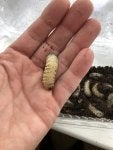Long time back I remember breeding them, was working with endangered birds (Galliformes from around the world) and the supply of mealworms were for the chicks when they came out of incubators. Tried to replicate a mother teaching the chick to feed by using a pair of tweezers to pick up and drop the mealworms in front of them, till they got the hang of feeding themselves.
Anyway, far as I can remember breeding them consisted of a couple of trays with bran or something, keep them warm and nothing else - we just took what we wanted out - they looked after themselves. No idea how they get moisture? Not ure I would know how to get one on the hook, need my glasses on ?.
I got this from a bird site :-
It can become quite expensive to constantly buy mealworms, so you might want to grow your own.
For a constant supply of mealworms, prepare a large circular biscuit tin as follows:
- Punch small holes in the lid for ventilation, place a layer of old hessian sacking in the bottom and sprinkle fairly thickly with bran. Put a slice or two of bread and raw potato, followed by another two layers of sacking/bran/bread/potato, like a three-decker sandwich. You can put a raw cabbage leaf on top if you like. Keep the tin at room temperature, not in hot sun.
- Introduce two or three hundred mealworms into the prepared tin. After a few weeks the mealworms will turn into creamy pupae, then into little black beetles.
- The beetles will lay eggs which hatch into mealworms and so on. Crop as necessary. Replace the bread, potato and cabbage as necessary.
- If you want to start new colonies, prepare another tin and transfer some bits of dry bread (these will carry beetle eggs) from the flourishing colony.
And this:-
The mealworm is a good – if slightly offbeat – roach, bream and chub bait. In fact it’s not a worm at all, but the grub of the mealworm beetle; it is slightly larger than a gozzer.
The adult beetle is of no use to anyone, except fishermen. It damages grain and cereal products in granaries and mills. But the mealworm itself makes a good source of food for the numerous pet birds that eat insects. It is quite widely available in pet shops, but be warned—it doesn’t come cheap. Fortunately, though mealworms are fairly expensive, they can be kept for a long time.
Maintaining mealworms
Store them in a well-ventilated container with clean bran or oatmeal inside for them to feed on. Keep them at an even temperature.
Some anglers keep mealworms long enough for them to turn into pupae, then into adult beetles which then breed. This way an everlasting bait supply is always at hand, especially since it is possible to fish with the pupae and adult beetles as well as the grubs.
Take them along to the bank in a maggot box pierced with small holes to provide air.
Mounting mealworms
Mealworms are fairly hard skinned, but they have a tendency to break off at the tail end during casting. This means that they should always be hooked through a middle segment, where they are much tougher.


